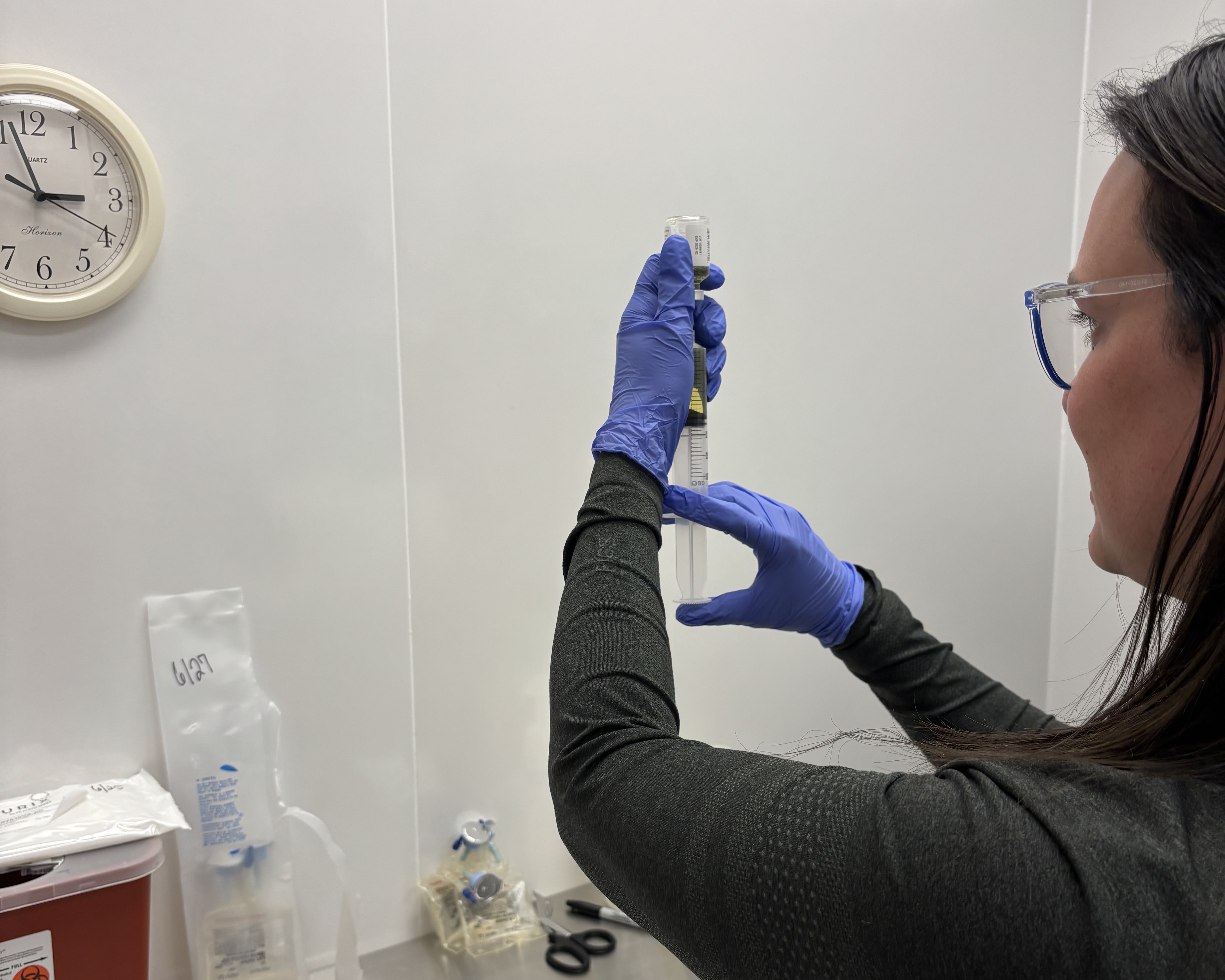News
Behind the Scenes: The Vital Role of Pharmacy at Mobridge Regional Hospital & Clinics
Posted 6/30/25 (Mon)

Photo: Dr. Charlie Tisdall, PharmD, prepares daptomycin—an intravenous antibiotic—for an outpatient. The patient will receive the medication from Katie Rau, RN, MRH&C’s Outpatient Infusion and Nurse Procedure Coordinator, over the next six weeks.
Many may not realize that two pharmacies operate within Mobridge Regional Hospital & Clinics (MRH&C). One is Family Pharmacy, a privately owned retail pharmacy visible to the public. The other is MRH&C’s own inpatient pharmacy, located inside the hospital—an essential, yet often unseen, component of patient care.
In this inpatient pharmacy, medication formularies are developed, optimal drug combinations for patient safety are evaluated, cost-effective strategies are implemented, and standardized order sets are created—such as medication bundles for critical events like heart attacks. These processes are designed to enhance care quality while reducing both risk and cost.
Located adjacent to the hospital’s new infusion center and inpatient rooms, the pharmacy team is responsible for preparing and dispensing medications for every inpatient, outpatient, and clinic patient at MRH&C. Every non-emergent medication order is reviewed by the pharmacy before administration. Even in the department where emergent orders are handled on the spot—the pharmacy team plays a critical role by stocking and maintaining the Omnicells (automated medication dispensing devices), along with all crash carts and emergency kits.
To illustrate the scope of their work: a single inpatient may have 15 or more active medication orders, many of which are administered multiple times each day.
Since joining MRH&C in October 2022, as the Director of Pharmacy, Dr. Lee Cordell, PharmD, has led a transformative expansion of pharmacy services across the organization. Relocating to Mobridge with his wife, Alex, and daughter, Camryn, while expecting their second child, Brooks, Dr. Cordell brought over a decade of clinical and operational experience. Prior to MRH&C, he served as the Pharmacist in Charge in Deadwood and still continues to serve as a State Pharmacy Inspector for South Dakota one day each week.
Under Dr. Cordell’s leadership, MRH&C has enhanced pharmacy oversight, expanded clinical pharmacist involvement in patient care, and laid the groundwork for advanced services like chemotherapy infusion. Recognizing the opportunity to strengthen clinical pharmacy services, Dr. Cordell was able to enhance patient care by bringing on Dr. Charlie Tisdall, PharmD—a recent graduate of South Dakota State University. Her addition has enabled deeper pharmacist engagement, expanded patient education efforts, and broader clinical coverage across the hospital.
Dr. Tisdall’s addition has expanded the department’s capacity, allowing for enhanced clinical services such as inpatient rounding, real-time provider collaboration, and discharge counseling. She also leads patient education efforts and plays a key role in the medication reconciliation process. After a provider enters an order and the nurse completes the initial reconciliation, Dr. Tisdall performs a final verification—an added layer of safety that significantly reduces the risk of medication errors and ensures optimal patient outcomes.
While pharmacists often serve as the visible clinical face of the department, MRH&C’s pharmacy technicians are the backbone of daily operations. Current Pharmacy Technicians Stephany Brockamp and Amanda Block play a vital role in every aspect of workflow—from managing inventory and preparing sterile and non-sterile compounds to restocking crash carts, maintaining Omnicell units, performing quality checks, and assisting in regulatory compliance. Their precision and reliability ensure safe and efficient medication delivery across the hospital.
Pharmacy is among the most tightly regulated professions in the country, subject to oversight from the FDA, DEA, state boards of pharmacy, and federal healthcare programs—surpassed in regulatory scrutiny only by industries such as nuclear energy. As such, ongoing training and compliance are essential.
Dr. Cordell’s dual role as Director of Pharmacy and state inspector has made him uniquely qualified to uphold these standards. He has completed—and continues to undergo—extensive training in sterile compounding, sterile hazardous compounding, and regulatory compliance that is constantly evolving. His expertise ensures that MRH&C not only meets but exceeds the highest expectations in pharmaceutical care and safety.
These efforts are especially timely as MRH&C prepares to launch chemotherapy and other hazardous infusion services through its expanding infusion center. In addition to preparing these complex medications, the pharmacy team is also prioritizing staff safety with a state-of-the-art sterile compounding setup.
“Our sterile hoods and negative pressure room are ready, and our team is fully trained and equipped,” says Dr. Cordell. “Each medication is unique, so we must develop them carefully in advance. Once we finalize the master formulary for a drug, we enter the compounding recipe into our pharmacy software, making the process repeatable and safe for all team members.”
As MRH&C continues to grow and enhance its services, the pharmacy team—supported by dedicated technicians and strong clinical leadership—remains at the heart of patient safety, innovation, and high-quality care.